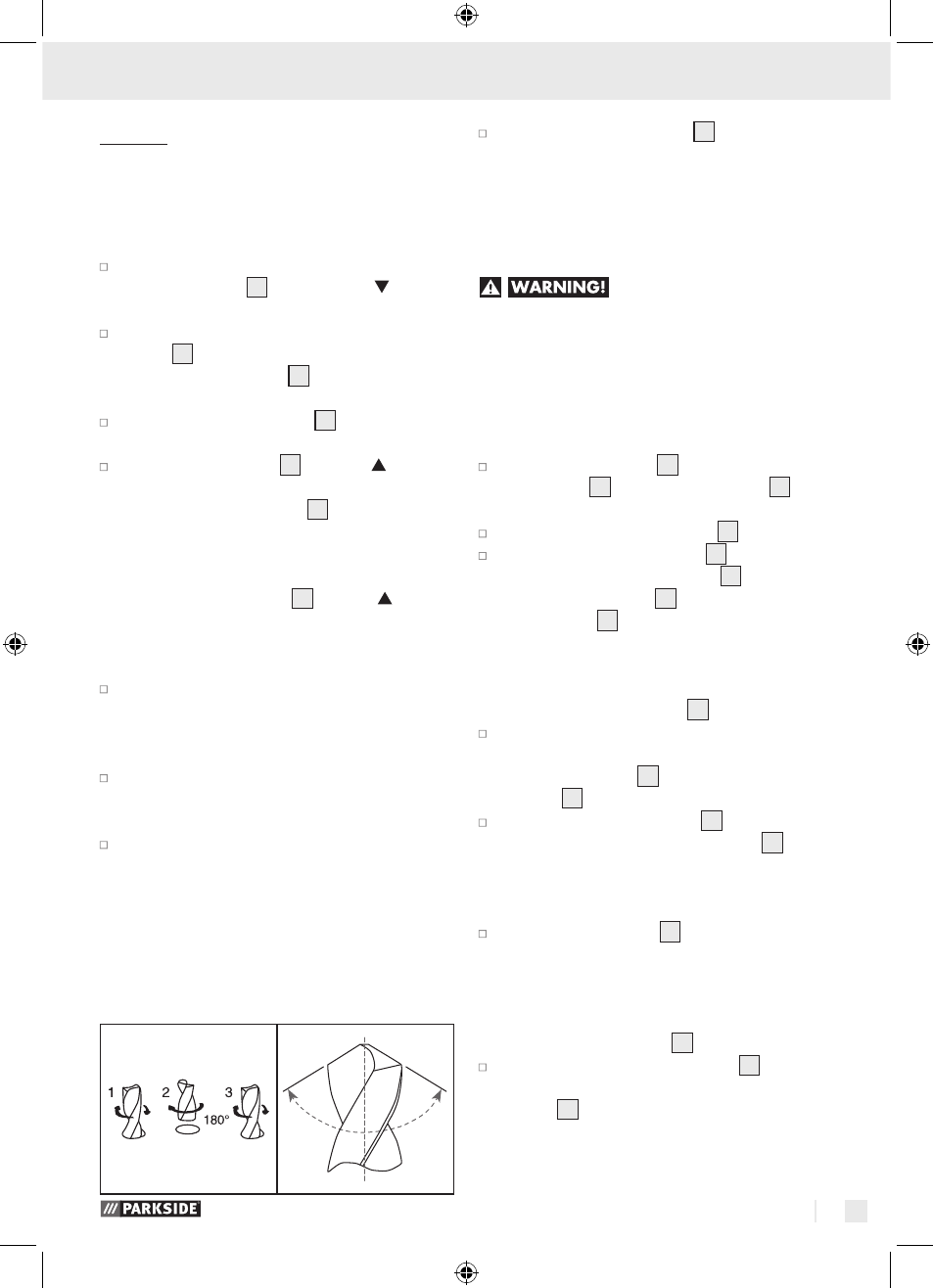Use general safety advice, Sharpening a drill, Replacing the sharpening stone – Parkside PBSG 95 A1 User Manual
Page 33

33
GB
Use
General safety advice
Q
Use
Q
Sharpening a drill
notE: Badly damaged drills should first be coarsely
sharpened on a sharpening block.
Fully lower the sharpening stone. To do this turn
the rotary switch
1
in the DOWN direction
as far as it will go.
Insert the drill into the smallest suitable drill
guide
11
on the drill sharpener. The exact size
(Ø) of each drill guide
11
is shown by the ad-
jacent lettering (3 to 10).
Press the ON / OFF switch
4
into position “I”
to switch on the device.
Turn the rotary switch
1
in the UP direction
until you hear a grinding noise.
notE: The rotary switch
1
controls the posi-
tion of the sharpening stone in the sharpening
head housing and therefore the pressure of the
sharpening stone against the drill. The further
you turn the rotary switch
1
in the UP direction,
the greater the pressure. Ensure that you do not
turn the sharpening stone too far up. Otherwise
the sharpening stone could strike the housing.
Turn the drill under slight pressure loosely and
quickly to and fro between the left and right
stops about 10 times (with small drills about 5
times).
Pull the drill out, turn it through 180° (horizontally)
and insert it again until it meets the sharpening
stone.
If necessary repeat whole process until both
cutting edges of the drill are sharp. Control the
grinding operation so that the angle between
the main and transverse cutting edges for a
standard drill is 130°. Both cutting edges (b)
must have the same angle to the drill axis (a)
and be the same length so that the drill runs
concentrically (see following figures).
(b)
(b)
(a)
Press the ON / OFF switch
4
into position “0”
to switch off the device.
Q
Replacing the
sharpening stone
RISk oF InJURY! Before you
carry out any work on the device, always pull the
mains plug out of the mains socket. Replace the
sharpening stone if it is worn out or damaged
(deteriorating, irregular sharpening performance,
broken stone). A Phillips screwdriver is required for
this step.
Screw the four screws
3
out of the sharpening
head cover
2
and remove the cover
2
, refer
to Fig. A.
Take out the sharpening stone
5
.
Clamp the sharpening stone
5
in a vice. Re-
lease the threaded connection
7
, which holds
the sharpening stone
5
on to the sharpening
stone holder
9
, using a 22 mm open spanner,
see Fig. B.
notE! LEFtHAnD tHREAD to RELEASE
tURn It CLoCkWISE!
Remove the metal washer
8
.
Mount the new sharpening stone, with its flat-
tened edge facing downwards, on to the
sharpening holder
9
and reinsert the metal
washer
8
.
Clamp the sharpening stone
5
again in a vice
and tighten the threaded connection
7
using
a 22 mm open spanner.
notE! LEFtHAnD tHREAD to tIGHtEn
tURn It AntICLoCkWISE!
Ensure that the spring
6
is inserted into the
device in accordance with Fig. D and insert the
sharpening stone back into the device. Turn the
sharpening stone until it goes precisely back
into place, as shown in Fig. A, otherwise the
sharpening stone cover
2
cannot be fitted.
Place the sharpening stone cover
2
back in
position and screw it in place with the four
screws
3
.
